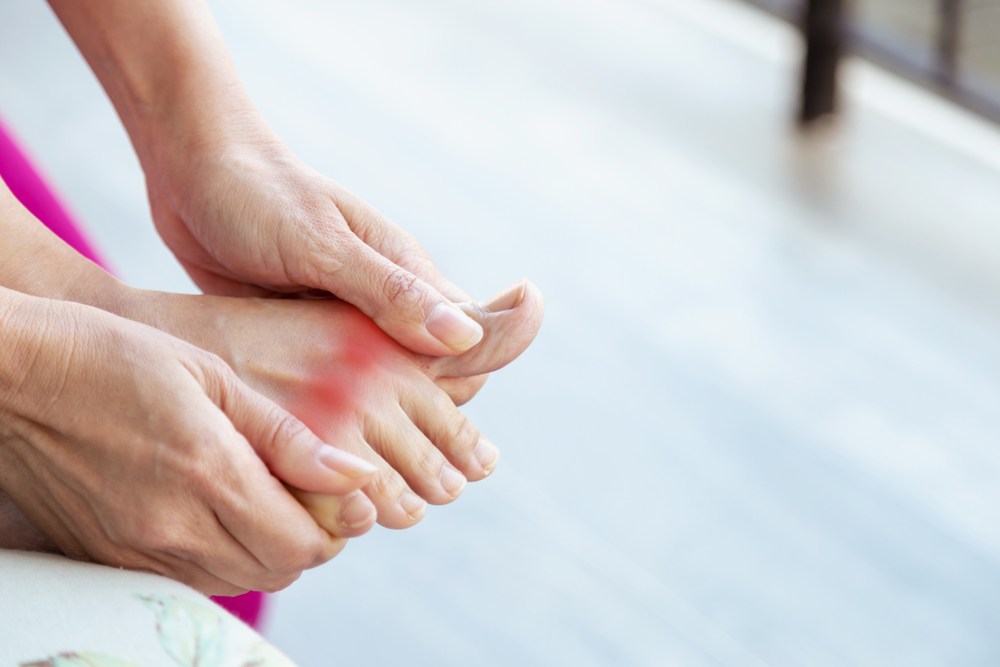
Dealing with Gout Pain
One of the most common forms of arthritis is gout, a painful joint condition that afflicts almost 8.3 million people in the United States. There are an increasing number of people in the U.S. suffering from gout, primarily because obesity, which plays a large role in acquiring this condition, is on the rise and the U.S. population is aging. Currently, almost 4 percent of the U.S. has been diagnosed with gout which is twice as high as in the 1960s.
What Is Gout?
Gout is classified as a type of arthritis because it causes pain, swelling and stiffness in the joints. It most commonly presents with swelling and pain in the joint where the big toe joins the foot. This swelling may be extremely sensitive with even minor contact producing excruciating pain. Gout attacks may strike at night and last from three up to ten days.
This condition develops when uric acid crystallizes in the joints, producing inflammation and intense pain. Uric acid is a normal byproduct of the breakdown of purines found in most protein-rich foods including red meat and seafood. Normally, uric acid is dissolved in the blood where it is filtered out by the kidneys, but this may not be possible if your body produces too much or if your kidneys are dysfunctional.
Diet plays an extremely important role in the onset and progression of gout. Foods that are high in purines are often the culprit, so it is best to avoid the following food and drink:
- Red meat
- Organa meat
- Seafood
- Alcohol
- Beer
Although sugary drinks with fructose are not high in purines, they do appear to raise the risk for a gout episode. It has been theorized that these kinds of drinks accelerate metabolic processes that produce uric acid. Similarly, you should avoid refined carbohydrates like those found in white bread or pastries.
It should also be noted that certain vegetables that are high in purines do not seem to raise the risk of developing gout or causing an attack.
How Gout Is Diagnosed
You may suspect that you have gout if have a sudden and intense pain in your joints, probably at night or early morning. Other symptoms may include tenderness, swelling or stiffness around a joint. If you ignore these early warning signs, you may develop tophi which are lumps under the skin where uric acid crystals accumulate. Tophi are not painful, but they deform the appearance of joints. Uric acid may also solidify in the kidneys and form kidney stones.
If you are exhibiting any of these symptoms, then you should visit your physician as soon as possible. In order to determine if you have gout rather than other forms of arthritis, your physician may perform several tests. It is likely that your doctor will draw blood and check for elevated uric acid levels; a high uric acid level does not necessarily mean that you have gout, but it could prompt additional testing.
If you do have high levels of uric acid in your blood, your physician should then take fluid from any joint that is inflamed or painful. Your doctor will then examine the fluid sample under a microscope to search for uric acid crystals. She may also perform an X-ray of your joints to rule out other joint conditions as well as an ultrasound to search for pockets of uric acid crystals.
You should really let your physician make the determination of whether you have gout or not. It is relatively easy to mistake other conditions like psoriatic arthritis, reactive arthritis or pseudogout for gout because they present with similar symptoms.
Managing Gout Pain
The good news is that gout is relatively easy to manage once you adopt the proper management program. These programs typically involve many, relatively minor life changes, including the following.
- Watch what you eat—you want to limit the amount of animal protein, sugary drinks and alcohol that you consume. Instead of red or organ meat, try chicken, pork or lamb, and salmon is one kind of fish that is relatively low in purines. You should eat a diet rich in fruits, vegetables, legumes, whole grains and dairy.
- Stay hydrated—maintaining a high level of water content can dilute the amount of uric acid in your blood and help your kidneys flush it out of your system. Drink water, coffee or tea throughout the day to help minimize the risk of an attack.
- Over the counter medications—most doctors recommend non-steroidal anti-inflammatory drugs like ibuprofen to manage your pain. You should avoid aspirin, however, as it has been known to aggravate gout pain symptoms.
- Steroids—during a gout episode, you may be given steroids like prednisone, if you cannot tolerate NSAIDs. Prednisone may be taken orally or as an injection and should be tapered off over a 10 to 14 day period.
- Gout drugs—there are drugs like Colchicine and Allopurinol that can be taken during or prior to a gout episode. These drugs limit symptoms by reducing the amount of uric acid in your body either through reducing production or boosting kidney function.
- Icing—it may not be feasible for patients with very painful and sensitive affected areas, but for many gout patients, icing may help. Use an ice pack or frozen peas to numb an area; you should limit applications to 20-30 minutes at one sitting, but you may have multiple icing sessions in a single day.
- Elevate your limb—if your pain symptoms are located in your lower leg or arm, you may relieve some of the swelling and pain by elevating it above the height of your trunk.
- Relax—your emotional state may play a large role in your gout episodes. Stress can help initiate an attack and may aggravate pain symptoms. If possible find some relaxing activity like watching a movie or listening to music to help take your mind off of your pain.
- Use a cane—you can take pressure off of a gouty leg by using a cane or wheelchair.
Article written by: Dr. Robert Moghim – CEO/Founder Colorado Pain Care
M.D. Disclaimer: The views expressed in this article are the personal views of Robert Moghim, M.D. and do not necessarily represent and are not intended to represent the views of the company or its employees. The information contained in this article does not constitute medical advice, nor does reading or accessing this information create a patient-provider relationship. Comments that you post will be shared with all visitors to this page. The comment feature is not governed by HIPAA and you should not post any of your private health information.



